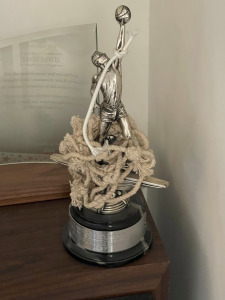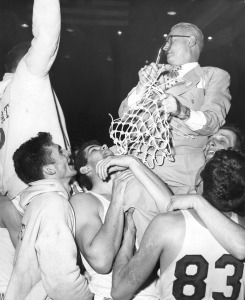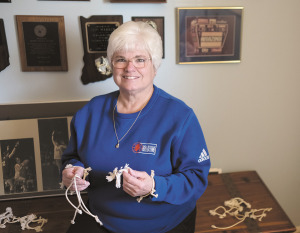Subscriber Benefit
As a subscriber you can listen to articles at work, in the car, or while you work out. Subscribe Now It’s as much a part of a championship game as the opening tip. A team wins, a ladder and scissors emerge, and players and coaches take turns cutting up and finally cutting off the net.
It’s as much a part of a championship game as the opening tip. A team wins, a ladder and scissors emerge, and players and coaches take turns cutting up and finally cutting off the net.
It’s weird when you stop to think about it. Winning baseball teams don’t slice up home plate, football teams don’t dig up chunks of grass, and tennis players don’t cut off pieces of their net for a keepsake. But there’s just something about the nets hanging from basketball rims that makes them too tempting to leave behind.
Low-hanging fruit, you might say. Just dangling there, less than 10 feet off the floor.
The habit of cutting off pieces of cotton, nylon, or whatever they make nets out of these days, was by all accounts born in Indiana. Figures, right? Google it, and you quickly learn that North Carolina State University coach Everett Case gets credit for popularizing it nationally, starting in the late ’40s.

Case happens to have been born, bred and indoctrinated in Indiana, where he directed Frankfort to state championships in 1925, ’29, ’36 and ’39. While he didn’t originate the net-cutting idea, he would have witnessed the procedure in the state tournament and adopted it when he took over at N.C. State.
What happens to all those stray snippings is another story. Some players still have them, some don’t, and some aren’t sure. Regardless, the very thought of them brings back memories of some of life’s highlights.
“It’s about tradition,” said Troy Lewis, who has kept portions of nets from Purdue’s Big Ten championships in 1987 and ’88 and Centerville (Ohio) High School’s 2021 state title, for which he served as an assistant coach.
“I can brag about it. It’s just something that meant a lot to me.”
Origin story
The first mention of a net coming down after a game in Indiana can be found in The Indianapolis News in 1927, after Martinsville defeated Muncie Central for the state championship. Some kid named Johnny Wooden scored 10 of Martinsville’s points that night, achieving his first bit of basketball glory in a career that would bring 10 opportunities to trim national championship nets as coach at UCLA.

It wasn’t a planned event, however. According to the News’ article, random fans performed the surgery: “The first frantic move following the great battle was toward the rough-hewn lace that listlessly hangs from the iron hoops, the boiling basketball kettles. Prominent whittlers from the victorious village rushed on to the huge anchored barge of basketball and shouted ‘Allez oop’ and immediately the basketball nets became souvenirs.”
Newspaper coverage reports nets taken down as part of the championship celebration through the rest of the ’20s, throughout the ’30s and into the ’40s, after which it had become so routine it didn’t always merit mention. It remained up to fans to perform the task for the first few years after the 1927 article, including in ’29 when Case won his second title. A Muncie Central cheerleader had the honor while riding on the shoulders of two city firemen in ’31.
The first mention of a player doing it was in ’33—Martinsville’s star, Wayne Garrison. Frankfort’s unnamed student manager took care of it in ’36. When Case won a fourth title for Frankfort in ’39, The Indianapolis Star described one player, Lewis Cook, as “wearing as a necklace the nets from one of the baskets through which he had helped pour the points.”
It’s unclear when ladders were first implemented and team members took turns cutting up nets, but Case obviously was well-grounded in the art by the time he took over as North Carolina State’s coach in 1946. He had coached Indiana high school teams from the time he was 18 years old (yes, 18), at Connersville High School and won 726 games—ample time to witness and experience all sorts of ways to promote and celebrate the game. He further applied his marketing flair at N.C. State by instituting such attractions as pep bands, spotlight player introductions and an applause meter.
His program twice ran afoul of the NCAA, bringing probations, but his innovations and fast-breaking style of play popularized college basketball in the South. His first team at N.C. State won the Southern Conference title in 1947. Of his 10 players, nine were freshmen, and six were from Indiana high schools. After that group defeated North Carolina to win the conference tourney, a photo taken of a celebrating group of players on the court showed one of them, Lawrence Central High School grad Pete Negley, with a net draped around his neck.
The following year, after the school repeated as conference champion, a similar photo showed another player, Jack McComas, wearing a net. “It’s an old Indiana custom to cut down the nets following a tournament championship,” the caption explained.
That custom spread and persisted, and now it’s a virtual given following championship games at all levels.
Saved, forgotten, lost
The net returns, however, are unpredictable. A large portion of a net might go in a school’s trophy case, but the strands collected by players, coaches and other team personnel tend to scatter. Some are kept, some are lost.
Isiah Thomas was featured on the cover of Sports illustrated in 1981 cutting down the net after Indiana won the national championship. One would think, if any part of any net would ever be kept, that would be it.
“I don’t have it,” Thomas said via text. “I wonder where it ended up.”
Given how many places Thomas has lived since leaving IU, it could be anywhere.
Randy Wittman has kept his piece of net from that night. Landon Turner, a forward on that team, has a piece of net at home but isn’t sure if it’s from that championship game or from the sectional or regional title his Indianapolis Tech team won his senior year in high school.
Bill Keller led Washington High School to the state championship in 1965, which he considers the highlight of a career that included successful seasons with Purdue and the Pacers. He has maintained the memories but isn’t sure about the net.
“I think I have some stuff in Bloomington,” he said, referring to his summer residence. “I’m not sure what I do have, to tell you the truth. I’m not sure if I’ve pitched it or not.”
Teammate Ralph Taylor, who, like Keller, went on to play at Purdue, gave away his strands of the championship net.
Pete Trgovich was the leading scorer on the East Chicago Washington team that won the state title with an undefeated season in 1971. He’s got his share of the net draped over the trophy he received for being voted the team’s most valuable player. He loves the net because it represents a team accomplishment but hates the trophy because he doesn’t believe anyone should have received an individual honor on such a multi-talented team.
Trgovich also was a member of two of Wooden’s NCAA championship teams, including the final one in 1975. He doesn’t recall getting net proceeds from either of those titles. South Bend native Mike Warren, meanwhile, didn’t get to play on a state championship team but can be seen with the net around his neck in on-court postgame team photos after UCLA won titles in 1967 and ’68.
He believes he has “remnants of it somewhere in the garage” but isn’t sure.
‘It goes where I go’
Judi Warren has a piece of one of the most historic nets in Indiana basketball history. She led Warsaw through an undefeated season to the first girls state tournament championship in 1976, when she also was voted Miss Basketball. She later had opportunities to cut nets in coaching stops at Maconaquah and Carmel.
Her players at Maconaquah were so unaccustomed to the practice that she put them through a tutorial before they won their sectional. She had her players cut the net into squares so they could wear the souvenir on their wrists.

“Just something different,” she said.
Her teams at Carmel won more net-trimming titles, once reaching the final game of the state tournament. It got to the point she occasionally gave away her piece of the net to a young fan as a form of encouragement. She kept most of them, however, and keeps them in a box that includes other memorabilia.
“It goes where I go,” she said. “I have several of them, but I don’t always know which one is which.”
Former IU coach Tom Crean directed one of the state’s most unique net-cutting ceremonies in 2013. His team had clinched a share of the Big Ten title heading into its final regular-season game but squandered a chance to win it outright by losing to Ohio State at Assembly Hall. Still wanting to reward his players, he took them out to the court in a nearly vacant Assembly Hall well past midnight to take down the nets.
“These guys have earned that,” he said at the time. “I have a responsibility to them.”
Crean at least waited until after a game to do it. Net-cutting is such a symbolic institution that some coaches have used it to motivate. Notre Dame coach Digger Phelps had his players cut down a net at the end of practice the day before his team ended UCLA’s 88-game winning streak in January 1974.
Lewis, Indiana’s co-Mr. Basketball in 1984, got a jump on all of them while growing up in Anderson.
“In my driveway, when the nets got ripped up, we would have a tournament and whoever won would cut down the nets before we put up a new net,” he said. “That led to wanting to do it for real in the sectional. That was a huge deal, getting up on that ladder in the Wigwam and cutting the nets down.”
Final cut
Case, also an Anderson native, surely would have gotten a kick out of that. For him, net cutting was merely a way to carry on an Indiana tradition and add some flair to postgame celebrations. His coaching success later earned him admittance to the Naismith Hall of Fame, but it didn’t end on his terms. He was forced into retirement by ill health after two games in the 1964-1965 season. His assistant, Press Maravich, led the team to another conference title at the end of the season. And when it came time to clip the nets, a frail Case was wheeled out onto the court, hoisted onto the shoulders of a few players, and given the honor of making the final cut.
He died barely more than a year later at age 65, but his legacy lives on after every meaningful championship game. And even in neighborhood driveways.•
__________
Montieth, an Indianapolis native, is a longtime newspaper reporter and freelance writer.
Please enable JavaScript to view this content.
